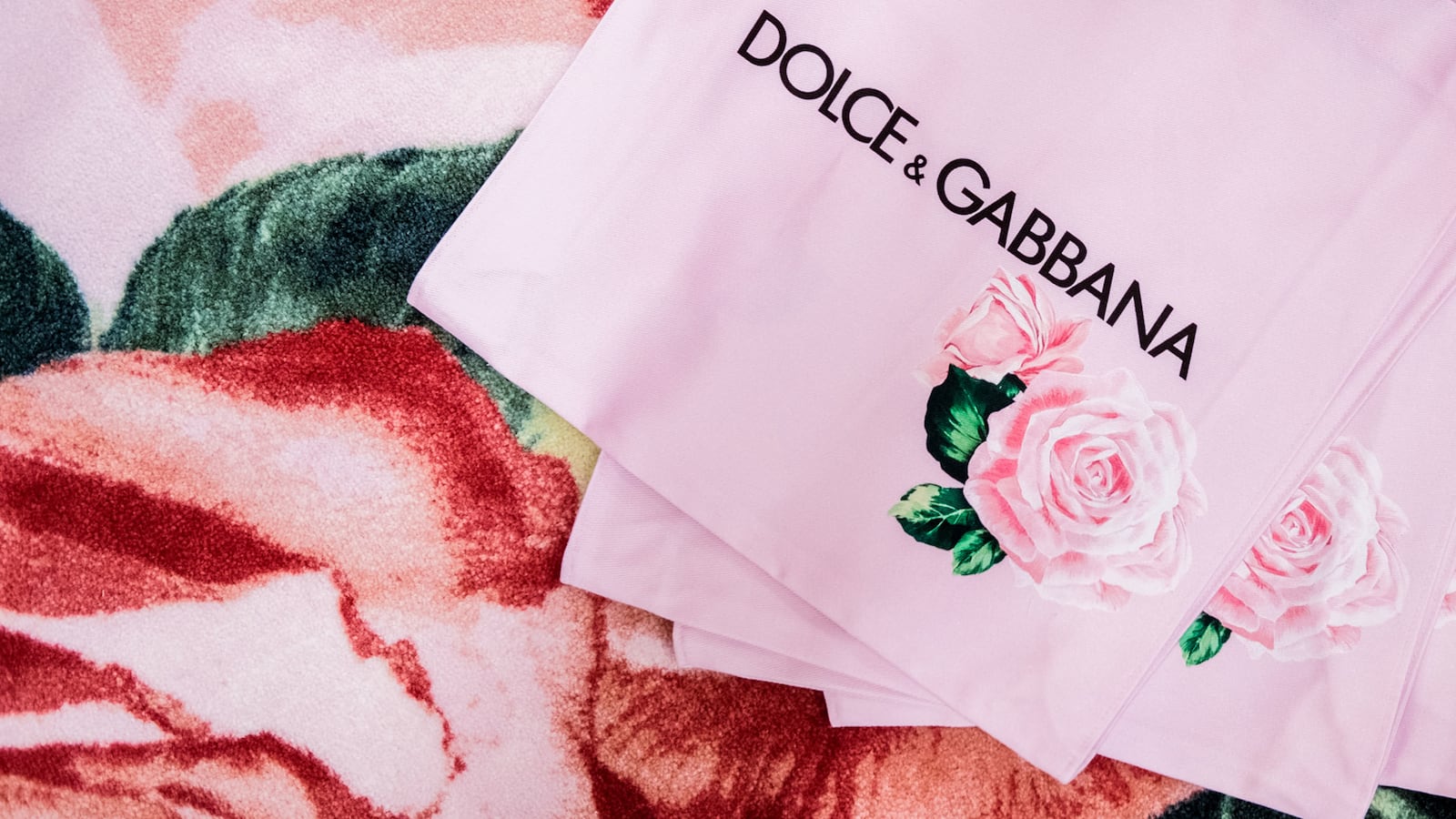#BoycottDolceGabbana has become almost as perennial a Twitter hashtag as #MondayMotivation or #SponsoredPost.
The ever-controversial line has a dubious resume that includes design snafus like releasing blackamoor earrings or $2,395 “slave sandals.” Founders Domenico Dolce and Stefano Gabbana have stoked controversy before, whether it be in the form of calling babies born from IVF “children of chemicals, synthetic children” or making unsolicited, negative comments about the singer Selena Gomez's appearance.
But just when many Dolce critics believed they had become desensitized to the antics of both founders—especially 56-year-old Gabbana, the more outspokenly vitriolic half of the pair—came the events of last week.
In an effort to court the Chinese market, Dolce & Gabbana planned a social campaign dubbed #DGLovesChina, which was to culminate in an extravagant Shanghai fashion show featuring around 300 models.
Money-wise, the spectacle made sense. “The Chinese consumer has an incredible appetite for luxury, at levels that are unprecedented,” Elizabeth Shobert, director of marketing and digital strategy for retail analytics company StyleSage, told The Daily Beast.
The Chinese luxury market is worth an estimated $7 billion annually, with most of those sales driven by mobile payment apps. The Wall Street Journal reported that Chinese shoppers spent $9 trillion on such transactions in 2016. (To compare, US customers coughed up $112 billion.)
“I’d say there are two groups of luxury consumers in China: those who identify with the brands or designers, and those who acquire luxury items as identity or status symbols,” said Jianhua Zhao, associate professor of anthropology at the University of Louisville and author of The Chinese Fashion Industry: An Ethnographic Approach.
Dolce, known for form-fitting, screen siren-esque designs that are promoted by the likes of Emily Ratajkowski, Scarlett Johansson, and Emilia Clarke, falls into the latter category.
So the label’s choreographed foray into China’s social media sphere was strategic—save for one crucial, glaringly obvious misstep.
On November 21, Dolce & Gabbana posted a video to Weibo, a popular Chinese social media platform, showing an Asian model attempting to eat pizza, spaghetti, and a cannoli with chopsticks. (Over the scene, a male narrator leeringly asks of the dessert, “Is it too huge for you?”)
The clip earned immediate international condemnation, with many calling the ad lazy, stereotypical, and downright racist. “Seriously what’s wrong with their marketing team, do they live in 1908?” one Twitter user wrote. Another echoed, “Am I in 1800?”
It would not be the first or last time a Western brand capitalized off of exoticism. Perhaps the controversy would have died down, save for the fact that the Instagram account Diet Prada posted screenshots of Gabbana equating Chinese culture to the poop emoji, calling those who were offended “inferior,” and suggesting that Chinese people “eat dogs.”
Gabbana’s PR team would report that his account had been hacked, a claim many do not believe. (Dolce & Gabbana did not respond to a request for comment from The Daily Beast.)
“My initial reaction was that this is 100 percent something Stefano would say,” said Timothy Parent, a creative consultant based in Shanghai. “I wasn't initially offended by the ads, and no one really thinks that is the main issue. The main issue is calling the entire country a pile of shit and unfairly stereotyping and extrapolating.”
The show was promptly cancelled. In an Instagram post addressed to the founders, Estelle Chen, a French model who was cast in the show, wrote: "You don't love China, you love money. China is rich yes but China is rich in its values, its culture, and its people and they won't spend a penny on a brand that does not respect that.”
Lucky Blue Smith, an American model, also pulled out from the show in solidarity with Asian members of the cast.
There was one major Dolce endorsement, though—Melania Trump, a noted fan, wore a high-necked black lace dress from the line’s 2016 collection to Thanksgiving at Mar-a-Lago.
By Black Friday, the creative team that so often feeds off of their outbursts released an apology video. Over the course of a minute and 25 seconds and one wide shot, Dolce and Gabbana sat in front of a red, baroque-patterned wall. In matching black turtlenecks, the pair read a statement.
“We will never forget this experience and it will certainly never happen again. We will respect the Chinese culture in every way possible. From the bottom of our hearts, we ask for forgiveness,” Gabbana said. The video finished with the duo saying “Sorry” in Chinese.
The scripted video was met with little forgiveness, and pledges to not forget. “No one really believes their apology and they have already been branded as racists and misogynists who only want Chinese money,” Parent said. “The only way to maybe bounce back a bit would be to fire Stefano, but even then the damage has been done.”
The Chinese leg of Net-a-Porter swiftly pulled the line from its virtual shelves, a move made by other e-commerce sites in the country such as AliBaba, JD, and Secco.
The New York Times reported that Chinese writer Xiang Kai had joined a growing social media protest, proudly burning over $20,000 worth of Dolce garb. As Kai said, “Some people say you’ve wasted a lot of money. I’m willing to waste this money for the nation’s dignity.”
Despite China’s staunchly patriotic reputation, government officials are trying to downplay the disrespect. Chinese Foreign Ministry spokesman Geng Shuang told The New York Times that “The Chinese side does not want this matter to rise to a diplomatic issue.”
But others are more than happy to draw lines in the sand that are as constricting as the waistline of a Dolce corset dress. “If you aren’t anti-Dolce, then you are anti-China,” Parent, the consultant, bluntly put it.
He went on to say that influencers have pulled together in a “united front” against the line, even if some individuals do not have strong feelings on the matter. “It is a good PR move to stand against racism, misogyny, and any other kind of prejudice,” he wryly noted
Professor Zhao called the events of last week a “disaster,” and predicted that “D & G will surely lose the appeal as a status symbol for Chinese consumers, and those who bought the line’s products would now regret their purchases.”
Ahead of festivities for the Chinese New Year, which begin in February and are often celebrated with shopping and gift-giving, Dolce & Gabbana could find itself cast aside in the market it tried so desperately to woo.
As Zhao put it, “The bottom line is that consumers buy luxury products to make themselves feel better, not insulted. ”





